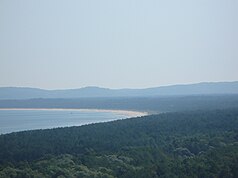Wolin National Park
| Wolin National Park | ||
|---|---|---|
| National park coat of arms | ||
|
|
||
| Location: | West Pomerania , Poland | |
| Next city: | Międzyzdroje ( Miedzyzdroje ) | |
| Surface: | 109.37 km² | |
| Founding: | 1960 | |
| Woliner chain from the west | ||
The Wolin National Park ( Polish Woliński Park Narodowy ) is a national park in Poland , which is located at the mouth of the Oder in the north-western part of Poland, near the German-Polish border. The eponymous island of Wolin , on which the national park is located, is the largest Polish island. After its creation in 1960, the park was expanded to include the islands in the Swine Delta in 1996. Furthermore, parts of the Baltic Sea (beach and sea areas) east of the city of Międzyzdroje ( Miedzyzdroje ) have been added.
General
The extremely valuable north-western part of the island of Wolin is protected by the national park . As part of the Pomeranian Bay and the Szczecin Lagoon belong to the park area, the Wolin National Park is the first marine nature park in Poland. The landscape of the national park is extremely varied. The characteristic element is a cliff extending over 15 km and up to 95 m high . The cliff shifts by about 80 cm annually as a result of storms, wind and sun. Its waters are also dominant for the appearance of the national park. In the northern part these are the water landscapes of the Baltic Sea and in the west that of the Świna delta . The delta of the Swina is an ensemble of 44 marshy islands and islets, which are separated from one another by channels with different directions of flow and different water levels and which are temporarily flooded and reshaped.
Geographically, this area was shaped about 12,000 years ago by pre- and post-glacial processes, and subsequently by wind and waves.
flora
Wolin Island is home to over 1300 species of vascular plants. These include many protected and rare species. Of the forest communities, the beech forests in particular are well preserved, the structure of which is very similar to the former primeval forests that lived here. The best preserved beech communities are located in two strictly protected areas in the southern part of the park and in two areas in the northern part. An orchid beech forest can also be visited here. Various dune plants are also characteristic of the Wolin National Park. A number of halophilic plants grow on the salty sheets of the Swina .
fauna
The animal world is very diverse and has a lot of rare species. On the one hand, this is due to the fact that the main migration route for many birds is via the island of Wolin. Therefore the occurrence of more than 230 bird species could be proven (among others: white-tailed eagle - heraldic animal of the national park, sedge warbler , dunlin , miniature flycatcher ). On the other hand, the national park plays an essential role in protecting the habitats of marsh birds, which find peace and food here, especially during the migration periods in spring and autumn. The Swina Delta region has been declared a haven of European importance for birds. The national park also has bison as a special attraction .
Memorial stones
On the Kaffeeberg (Polish: Kawcza Góra) there is a memorial stone from 1892, which commemorates the 21st gathering of German foresters . The memorial stone was originally erected on the Gosanberg in 1892 and fell into the Baltic Sea in the 1930s when the cliff coast was demolished. It was salvaged in 1991 by Polish fishermen and was given its new location here in 1992 on the occasion of a conference of the Polish Forestry Society. A memorial stone from 1992 for the conference of the Polish Forest Society as well as a stone with explanatory boards erected in 2006 are also on the Kaffeeberg .
See also
Web links
- Wolin National Park site (Polish / English / German)




